Berkeley Earth, a California-based non-profit research organization, has been preparing independent analyses of global mean temperature changes since 2013. The following is our report on global mean temperature during 2021.
We conclude that 2021 was nominally the sixth warmest year on Earth since 1850. Our estimate of the global mean temperature in 2021 was significantly colder than 2020, but similar to 2018 and 2015. Given the uncertainties associated with temperature measurements, all three of these years 2015, 2018, and 2021 are essentially tied as the fifth, sixth, and seventh warmest years.
The last seven years have included all seven of the warmest years observed in the instrumental record.
Year-to-year rankings are likely to reflect short-term natural variability. In 2021, a persistent La Niña event is believed to have reduced temperatures somewhat compared to years without a La Niña event. Overall, the long-term trend remains consistent with an ongoing pattern of global warming.
While not a record warm year overall, 8.3% of the Earth’s surface did have a record warm annual average locally in 2021. By chance, these areas coincided with a number of major population centers. We estimate that ~1.8 billion people experienced a record high annual average in 2021, including most of the population of China.
In addition, 2021 was notable for:
- New record high annual averages for 25 countries, including China, South Korea, and Nigeria
- A relatively cool year in the Arctic Ocean
- A number of extreme weather events, including a record-smashing heat wave on the Pacific coast of North America
- Nominally the 5th warmest year on land and the 7th warmest year in the oceans.
Annual Temperature Anomaly
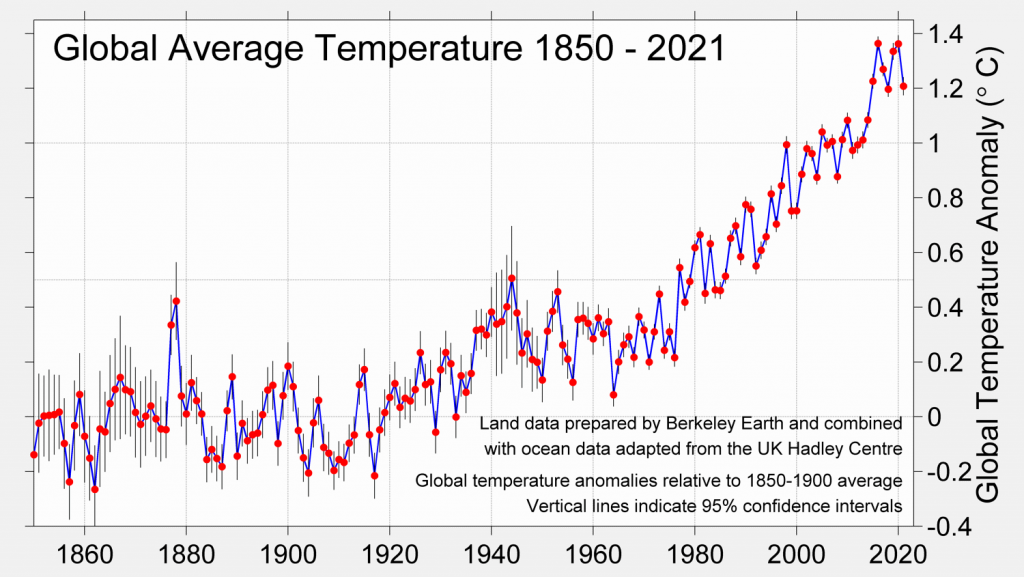
The global mean temperature in 2021 is estimated to have been 1.21 °C (2.17 °F) above the average temperature from 1850-1900, a period often used as a pre-industrial baseline for global temperature targets. This is ~0.15 °C (~0.28 °F) cooler than in 2020. As a result, 2021 is nominally the sixth warmest year to have been directly observed, though the years 2015, 2018, and 2021 all cluster closely together relative to their uncertainty estimates. Hence, the fifth, sixth, and seventh warmest years are all essentially tied.
This temperature in 2021 is equivalent to 0.90 °C (1.63 °F) above the 1951-1980 average which is often used as a reference period for comparing global climate analyses.
The last seven years stand out as the seven warmest years to have been directly observed.
| Year | Rank | Warming in °C | Warming in °F |
| 2021 | 6 | 1.21 ± 0.03 | 2.17 ± 0.05 |
| 2020 | 2 | 1.36 ± 0.03 | 2.45 ± 0.06 |
| 2019 | 3 | 1.33 ± 0.03 | 2.40 ± 0.06 |
| 2018 | 7 | 1.20 ± 0.03 | 2.15 ± 0.05 |
| 2017 | 4 | 1.27 ± 0.02 | 2.29 ± 0.04 |
| 2016 | 1 | 1.36 ± 0.03 | 2.45 ± 0.05 |
| 2015 | 5 | 1.23 ± 0.03 | 2.21 ± 0.05 |
| 2014 | 8 | 1.08 ± 0.03 | 1.95 ± 0.05 |
| 2013 | 12 | 1.01 ± 0.03 | 1.82 ± 0.06 |
| 2012 | 15 | 0.99 ± 0.03 | 1.79 ± 0.06 |
| 2011 | 18 | 0.97 ± 0.03 | 1.75 ± 0.05 |
| 2010 | 9 | 1.08 ± 0.03 | 1.95 ± 0.05 |
The temperature uncertainties can be visualized using the schematic below where each year’s temperature estimate is represented by a distribution reflecting its uncertainty. In the analysis that Berkeley Earth conducts, the uncertainty on the mean temperature is approximately 0.03 °C (0.05 °F) for recent years. The global mean temperature in 2021 fell squarely between those observed in 2018 & 2015. These three years have substantially overlapping uncertainties, leading to an associated uncertainty in the true relative rankings of these years.

The last seven years have been part of a period of significant warmth well above all previous years since 1850. This reflects the long-term trend towards global warming. Though 2021 is cooler than some of the other recent years, its overall temperature remains consistent with the long-term warming trend.
Land Average Temperature in 2021
On land, 2021 was nominally the fifth warmest year observed, and effectively tied with 2015. This is significantly cooler than 2020, which was the warmest year on land.

In 2021, the land average temperature was 1.70 ± 0.04 °C above the average temperature from 1850 to 1900. As discussed below, though it was only the fifth warmest year overall, some territories saw record warm annual averages in 2021.
Temperature Distribution in 2021
The following map shows how local temperatures in 2021 have increased relative to the average temperature in 1951-1980.
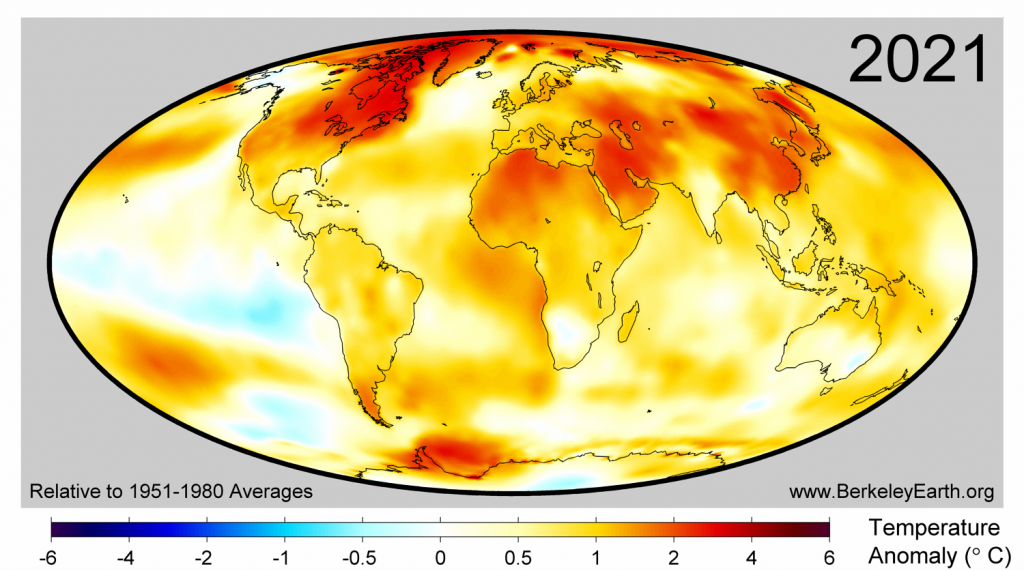
As can be expected from the global warming caused by greenhouse gases, the temperature increase over the globe is broadly distributed, affecting nearly all land and ocean areas. In 2021, 87% of the Earth’s surface was significantly warmer than the average temperature during 1951-1980, 11% was of a similar temperature, and only 2.6% was significantly colder.
We estimate that 8.3% of the Earth’s surface set a new local record for the warmest annual average. In 2021, no places on Earth experienced a record cold annual average.
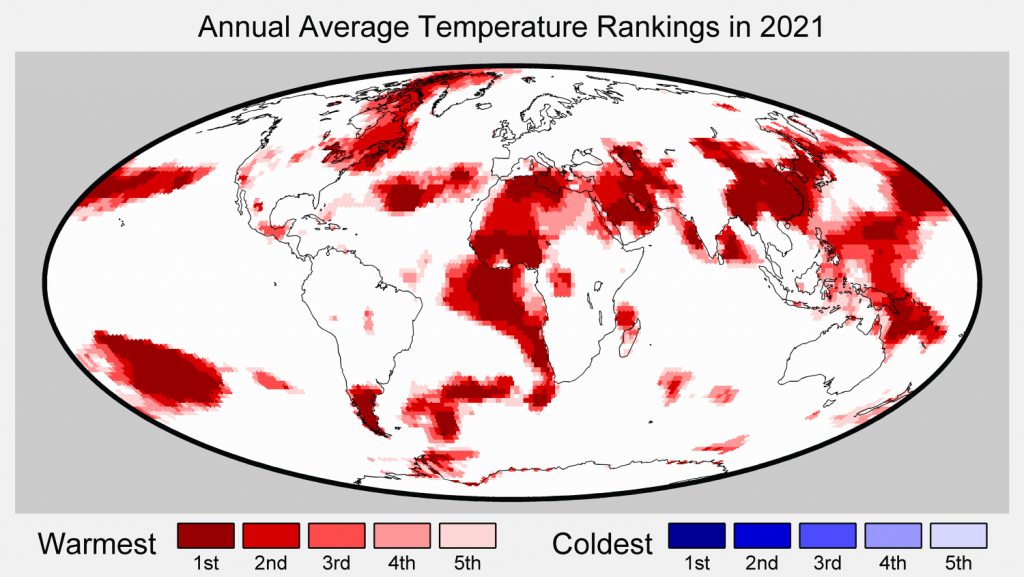
Land areas generally show more than twice as much warming as the ocean. When compared to the 1850-1900 averages, the land average in 2021 has increased 1.70 ± 0.04 °C (3.06 ± 0.08 °F) and the ocean surface temperature, excluding sea ice regions, has increased 0.83 ± 0.05 °C (1.49 ± 0.08 °F). 2021 and 2015 are nominally the 5th and 6th warmest years on land, though the tiny difference between them makes these years essentially tied. For the ocean surface, we find that 2021 nominally ranks as the 7th warmest year. However, the differences between the 5th, 6th, and 7th warmest years in the ocean are all small compared to the measurement uncertainty. The following figure shows land and ocean temperature changes relative to the average from 1850 to 1900. The tendency for land averages to increase more quickly than ocean averages is clearly visible.
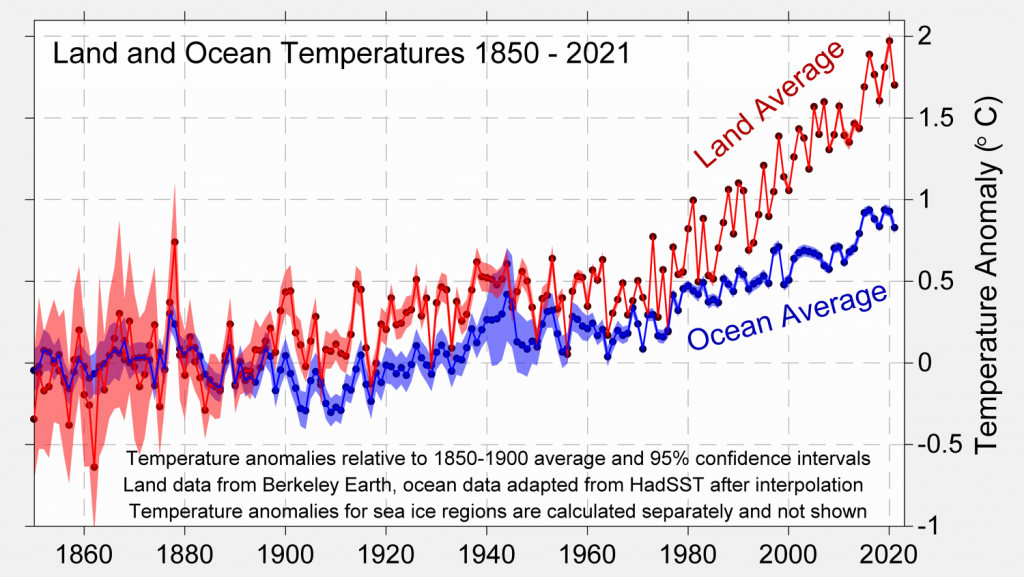
As in other recent years, 2021 also shows strong warming over the Arctic that exceeds the Earth’s mean rate of warming. This is consistent with the process known as Arctic amplification. By melting sea ice and decreasing snow cover, warming in the Arctic regions causes more sunlight to be absorbed, which allows for yet more warming. However, 2021 was not as warm as other recent years, and ranked only 13th overall. Similarly, sea ice melt in 2021 was less extreme than other recent years, though still well ahead on what was typical 30 years ago.
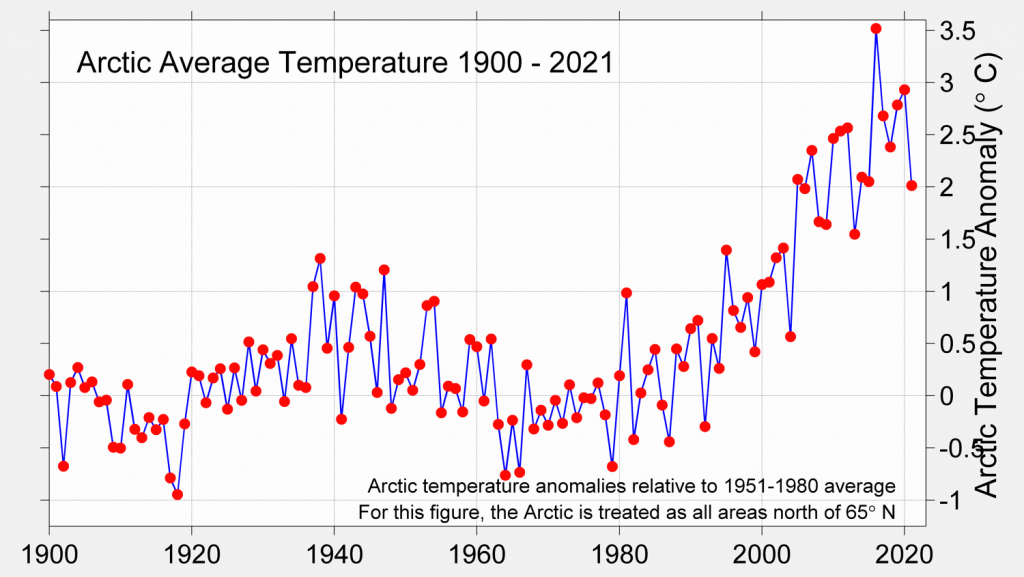
Both the tendency for land to warm faster than ocean and the higher rate of warming over the Arctic are expected based on our understanding of how increases in greenhouse gas concentrations will impact the Earth’s climate. As has been reported by the Global Carbon Project and other observers, 2021 saw a new record for the level of carbon dioxide in the atmosphere. This is due to the continued accumulation of carbon dioxide from human activities. The annual amount of carbon dioxide emitted in 2021 was 4.9% higher than 2020 and has nearly equaled the amount emitted in 2019 before the COVID-19 pandemic.
Development of La Niña
The emergence of the La Niña weather phenomenon in the latter half of 2020 had a substantial influence on temperatures at the end of 2020, and an even larger impact on 2021.
La Niña is characterized by the emergence of a large area of relatively cool water in the western equatorial Pacific, as can clearly be seen in this map of average temperatures from October to February. In addition to the immediate cooling in the Pacific, La Niña can have far-reaching effects on global circulation and weather patterns. This disruption of weather patterns tends to be associated with an extended period of somewhat reduced global average temperatures that can last for months beyond the peak of the La Niña in the Pacific.
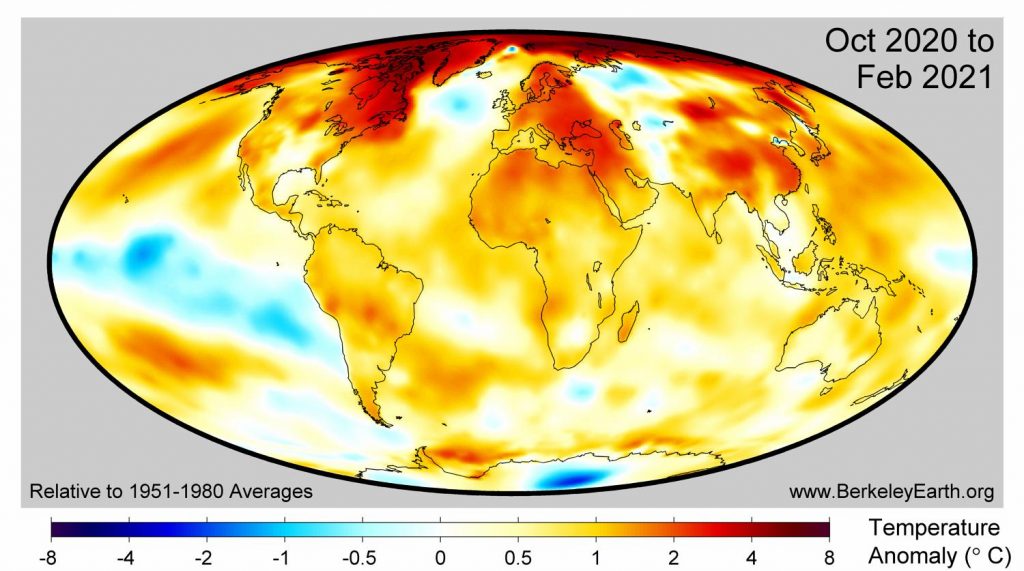
Notably, the monthly time series of ocean average temperatures shifted sharply lower at the end of 2020 due to La Niña. These somewhat reduced ocean temperatures helped to keep the global average temperature in 2021 lower than in other recent years.

Ocean temperatures in the equatorial Pacific briefly returned to neutral conditions during the middle of 2021, before cooling again at the end of 2021. This return to La Niña conditions at the end of 2021 is likely to keep global average temperatures away from record highs in 2022 as well.
National Average Temperature
Though the focus of our work is on global and regional climate analysis, it is also possible to use our data to estimate national temperature trends.
In Berkeley Earth’s estimation, 2021 had the warmest annual average since instrumental records began in the following 25 countries:
Bangladesh, Bahrain, Benin, Bhutan, Burkina Faso, China, Ghana, Guinea, Iran, Kuwait, Liberia, Malta, Myanmar, Nigeria, North Korea, Oman, Qatar, Saudi Arabia, Senegal, Sierra Leone, South Korea, Togo, Tunisia, Turkmenistan, United Arab Emirates
This is fewer than the 45 countries that experienced record warming in 2020, but especially with the inclusion of China this still represents a substantial fraction of the world’s population that has just lived through the warmest year in their local history. We estimate that approximately 1.8 billion people live in areas that observed their locally warmest year during 2021.
The following chart provides a summary of the warming that countries experienced in 2021 relative their 1951 to 1980 averages.

These estimates for the changes in national annual average temperatures are derived from our global temperature fields. Due to uncertainties in the analysis and the limits of our spatial resolution some national average estimates may differ slightly from the values reported by national weather agencies.
Temperatures in China
The annual average in China during 2021 set a new record high, exceeding 2.0 °C (3.8 °F) above pre-industrial levels for the first time. This record warmth occurred over many of the most populated regions of China and contributed to more than 1 billion people experiencing their locally warmest year.

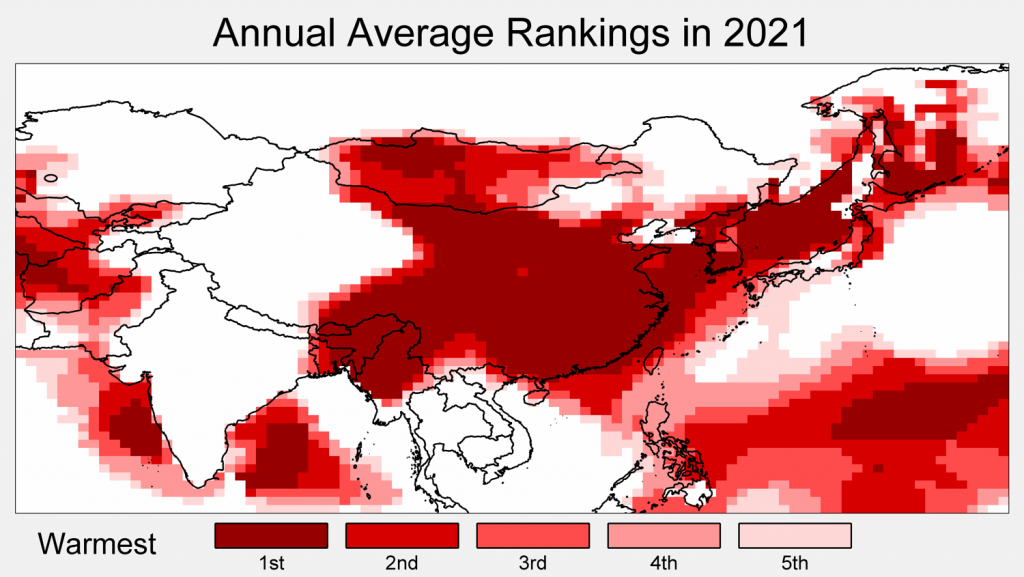
In addition, Hunan province in China broke their annual average record by nearly 0.7 °C (1.3 °F) above the previous record just set in 2020. This is largest margin by which an annual average record was exceeded anywhere on Earth in 2021.

Pacific Northwest Heatwave
There have been many memorable extreme events in 2021. Examples include the extreme flooding in China, and central Europe, severe wildfires in the US and Russia, and the December tornado outbreak in the USA. However, one of the most remarkable weather events in 2021 was the June heatwave impacting the Pacific coast of the USA and Canada.
This heatwave had a staggering intensity and set new all-time temperature records for Canada on three consecutive days. The previous national temperature record for all of Canada was 45.0 °C (113 °F) set in 1937, while the June heatwave reached 49.6 °C (121 °F), massively exceeding the previous record.

This heatwave was the most severe in terms of the temperature excess above normal of any heatwave ever observed during a summer in North America. It was also the deadliest weather event in Canadian history. Between the US and Canada, 798 deaths were directly blamed on the heatwave, though the true death toll is likely higher.
This heatwave has been directly linked to global warming, and would have been “virtually impossible” in the previous climate.
Monthly Temperature Patterns
Every month in 2020 was at least 1.0 °C (1.8 °F) warmer than the 1850 to 1900 average. However, the first several months of the year were relatively cool compared to other recent years, partly due to the effects of the La Niña occurring during that period. No months during 2021 set a new record high temperature for the month. September 2021 was the second warmest September, and three months ranked third overall. The relatively coldest month was February which ranked 14th in 2021. Despite the cold outbursts in February affecting both North America and Northern Asia, the global mean temperature in February was still significantly warmer than what was normal during the mid-20th century.

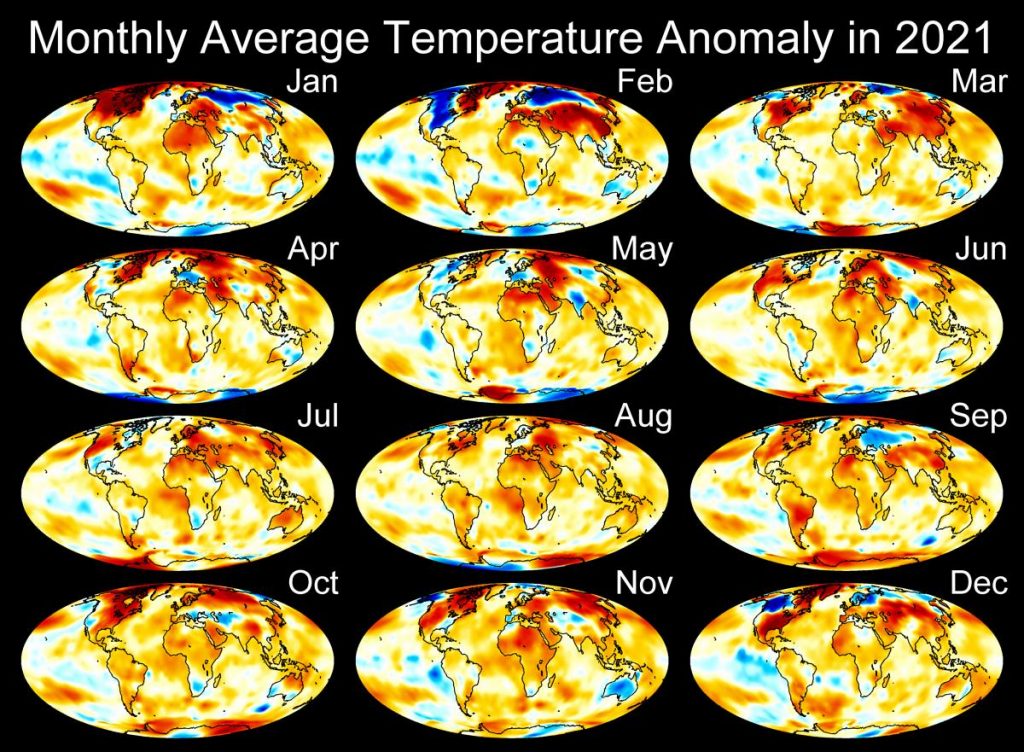
Long-term Trend
Though it is interesting to understand the characteristics of individual years, global warming is ultimately about the long-term evolution of Earth’s climate. The following chart shows a ten-year moving average of the Earth’s surface temperature, plotted relative to the average temperature from 1850-1900.
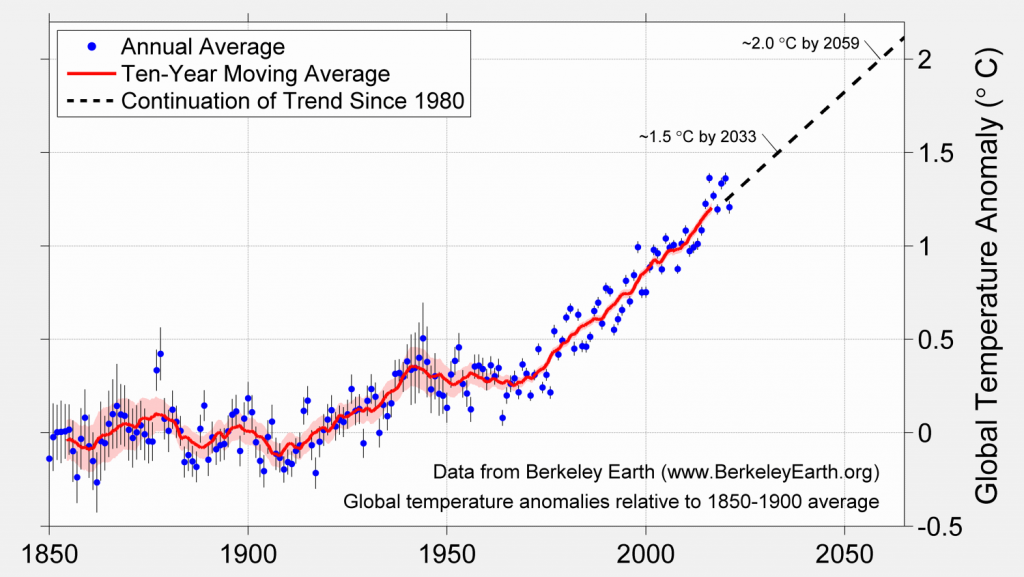
Since 1980, the overall trend is +0.19 °C/decade (+0.34 °F/decade) and has changed little during this period. By continuing this trend, we can make a rough guess of how the near-future climate may develop if the forces driving global warming continue at their present rate.
As shown in the chart, several recent years have had temperatures more than 1.2 °C (2.2 °F) above the average temperature from 1850-1900, often used as an estimate of the pre-industrial climate. The Paris Agreement on Climate Change aims to keep global temperature rise to well below 2 °C (3.6 °F) and encourages parties to strive for warming of no more than 1.5 °C (2.7 °F). At the current rate of progression, the increase in Earth’s long-term average temperature will reach 1.5 °C (2.7 °F) above the 1850-1900 average by around 2033 and 2 °C (3.6 °F) will be reached around 2060. The increasing abundance of greenhouse gases in the atmosphere due to human activities is the direct cause of this recent global warming. If the Paris Agreement’s goal of no more than 2 °C (3.6 °F) warming is to be reached, significant progress towards reducing greenhouse gas emissions needs to be made soon.
Global Mean Temperature Prediction for 2022
Based on historical variability and current conditions, it is possible to roughly estimate what global mean temperature might be expected in 2022. Our current estimate is that 2022 is likely to be similar to 2021 or slightly warmer. With the recent return of La Niña conditions, it is likely that 2022 remains relatively cool. The swings from El Niño to La Niña and back again are the largest source of interannual variability in the global temperature record, with La Niña associated with cooler conditions. However, there remains a modest chance (14%) that 2022 could end up as a new warmest year if the El Niño / La Niña system swings back to warmth early in 2022.
It is nearly certain (>99% likelihood) that 2022 will remain within the top-ten warmest years; however, there is a 50% chance that 2022 will rank no higher than the 5th warmest year.
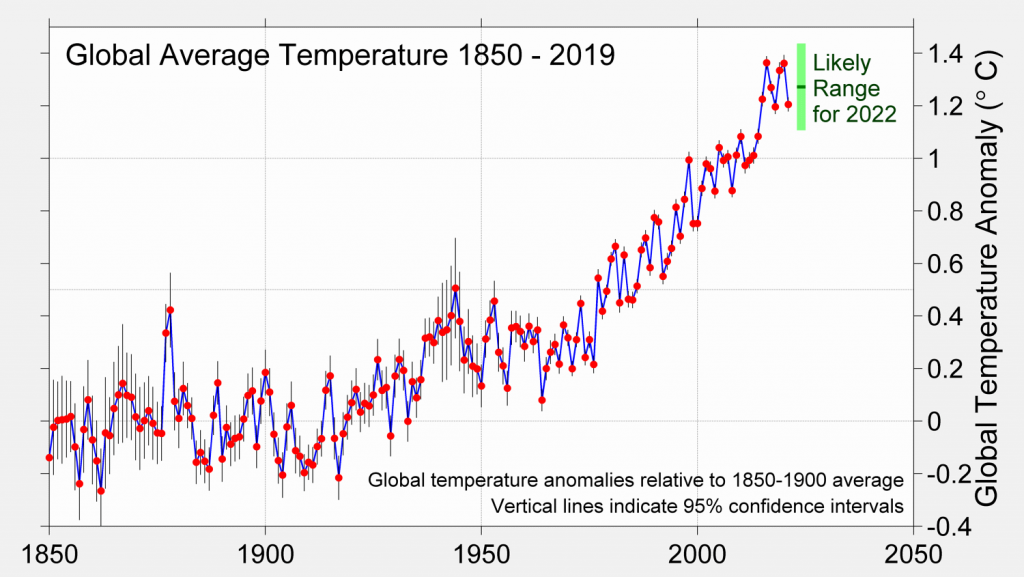
Though 2022 is expected to be somewhat cool, that does not mean that global warming has stopped. Like 2021, the central estimate for 2022 remains close to the long-term trend. Minor year-to-year fluctuations are entirely natural and may provide the world with a year of slightly less exceptional weather, but over the long-term temperatures are expected to continue along a warming trend as long as humans continue to add additional greenhouse gases to the atmosphere.
Comparisons with Other Groups
When preparing our year-end reports, Berkeley Earth traditionally compares our global mean temperature analysis to the results of four other groups that also report global mean surface temperature. The following chart compares Berkeley Earth’s analysis of global mean temperature to that of the NASA’s GISTEMP, NOAA’s GlobalTemp, the UK’s HadCRUT, and ECMWF‘s reanalysis. All of these groups produce a similar understanding of recent climate change. As of the time this document was being finalized, 2021 values for HadCRUT were not available.

NOAA and NASA concur with Berkeley Earth that 2021 was the 6th warmest year. ECMWF places 2021 as nominally the 5th warmest year, though with an insignificant margin of difference from the 6th warmest year..
Slight disagreements in the ranking are common and reflect both the uncertainty in these estimations and the differences in how various research programs look at the Earth. Each uses a somewhat different selection of source data and different methods of interpolation and correcting for measurement errors. Some methods are more limited than others. For example, NOAA omits most of the polar regions when estimating mean temperature changes. As a result, it is not surprising to see small disagreements among the groups.
Methodology
In reconstructing the changes in global mean temperature since 1850, Berkeley Earth has examined 21 million monthly-average temperature observations from 50,592 weather stations. Of these 18,881 stations and 150,000 monthly averages are available for 2021.
The weather station data is combined with sea surface temperature data from the UK Met Office’s Hadley Centre (HadSST). This ocean data is based on 443 million measurements collected by ships and buoys, including 20 million observations obtained in 2021. We reprocess and interpolate the HadSST data to provide a more complete picture of the oceans. After combining the ocean data with our land data, we arrive at a global picture of climate change since 1850.
This is the first year that Berkeley Earth has adopted the recently released HadSST version 4 in our report. Compared to HadSST version 3, which it replaces, version 4 uses more data and includes a reassessment of the effects of biases related to transitions in the technology used to measure sea surface temperatures. Historical measurement programs have evolved from sailing ships measuring buckets of water, to powered ships measuring engine intake water, to automated buoys, etc. Each transition in the measurement technology can introduce small inconsistencies in the reported measurements. In reassessing these issues, HadSST version 4 estimated that historical measurement biases were somewhat larger than previously believed. As a result, HadSST version 4 estimates the ocean has warmed somewhat faster than previous assessments. By extension, this results in somewhat greater total warming since the pre-industrial period in the Berkeley Earth global averages. This transition to HadSST vversion 4 is the main source of small upward revisions in historical averages in this report compared to Berkeley Earth’s 2020 report. These revisions also imply slightly less time is available before key thresholds, such as 1.5 °C, will be reached.
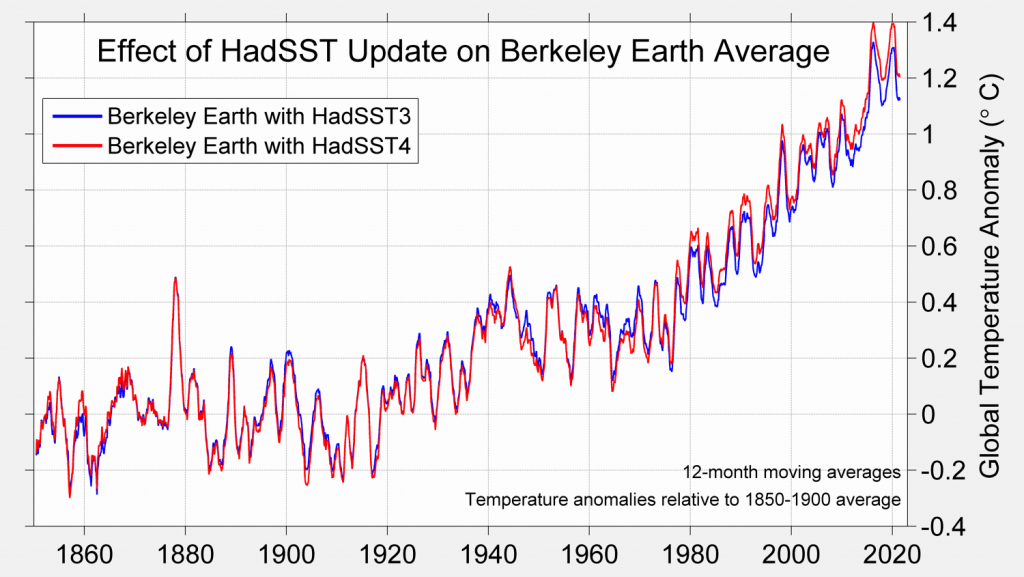
Uncertainties arise primarily from the incomplete spatial coverage of historical weather observations, from noise in measurement devices, and from biases introduced due to systematic changes in measurement technologies and methods. The total uncertainty is much less than the long-term changes in climate during the last 170 years.
This report is based on such weather observations as had been recorded into global archives as of early January 2021. It is common for additional observations to be added to archives after some delay. Consequently, temperature analysis calculations can be subject to revisions as new data becomes available. Such revisions are typically quite small and are considered unlikely to alter the qualitative conclusions presented in this report.
Copyright
This report was prepared by Berkeley Earth. The contents of this report, including all images may be reused under the terms of the Creative Commons BY-4.0 copyright license for any purpose and in any forum, consistent with the terms of that license.
Members of the news media may also use the materials in this report for any news reporting purpose provided that Berkeley Earth is properly acknowledged, without concern for whether or not the CC BY-4.0 license is followed.
Data
Updated data files will appear at our data page, and are updated monthly.
In particular, monthly and annual time series are available.

